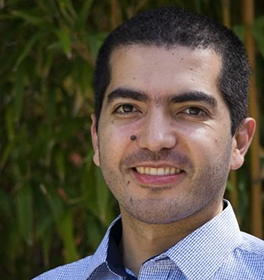86 BILLION NEURONS 1
Neurons communicate through electrical and chemical signals. The specific properties of the neurons composing a brain area and their connections with neurons in other brain areas, define the function of a brain area (e.g. language, vision, movement).
We Can Record Electrical Signals
There are different ways to record and monitor neural activity. Our solution is to provide electrodes that are placed on top of or within the brain and capture the activity of a group of neurons located underneath/around each contact. The signals recorded are called intracranial electroencephalogram (iEEG) or electrocorticography (ECoG) signals. The shape, amplitude and frequency of these electrical signals provide a readout of the activity of that brain area.
Neurological diseases may be associated with disturbances in neural activity and connectivity between brain areas. The changes in the shape, amplitude and frequency of recorded electrical signals may be used to identify areas with altered activity. 2
Epilepsy is the disease associated with spontaneously recurring seizures. A seizure is a sudden, uncontrolled electrical disturbance in the brain. It can cause changes in behavior, movements or feelings, and in levels of consciousness. There are different types of seizures and their characterization and classification helps guiding the treatment.
There are more than twenty seven FDA-approved drugs for the treatment of seizures. However, in ~1/3 of the patients medication fails to control their seizures. These patients are candidates for surgical options. 3, 4
Resource for information on Epilepsy, treatment and surgical options:
Patient selection for surgical options is based on non-invasive and invasive evaluations.
Phase 1 - Non-invasive 5
The first step to provide a baseline exam is performed in order to determine where the seizure activity in the brain begins. No surgery is required for this phase, and typically involves imaging.
Phase 2 - Invasive 6,7
When phase I results are not conclusive, patients undergo Invasive intracranial electroencephalography (iEEG) – or a Phase 2 evaluation, using:
This phase is typically performed usually in levels 3, 4 National Association of Epilepsy Centers*.







Mr. Rosa is an entrepreneur with three decades of experience in the medical device industry spanning a variety of technologies and products. In addition to CEO roles with early-stage medical device companies, Mr. Rosa’s background also includes senior roles with C.R. Bard Inc., Boston Scientific Inc., and St. Jude Medical, where his responsibilities included marketing, product development and business development. He has been named as an inventor on multiple medical device patents, serves on seven corporate boards, and has raised $200M in the capital markets. Mr. Rosa holds an MBA from Duquesne University and a BS in Commerce and Engineering from Drexel University.


Mr. McClurg has over 30 years of financial leadership experience with private and public companies. Prior to joining NeuroOne, Mr. McClurg was VP - Finance & Administration and Chief Financial Officer of Incisive Surgical, Inc., a privately-held medical device manufacturer, and Chief Financial Officer and Treasurer of Wavecrest Corporation, a privately-held manufacturer of electronic test instruments for the semiconductor industry. Mr. McClurg also served as Chief Financial Officer for several publicly-held companies, including Video Sentry Corporation, Insignia Systems, Inc., and Orthomet, Inc. Currently, he serves as a director for a privately held company. He began his career in public accounting with Ernst & Young, where he earned his CPA certificate. He holds a Bachelor of Business Administration degree in accounting from the University of Wisconsin – Eau Claire.


Mr. Volker has over 20 years of experience in the medtech industry including at Abbott, Cardiovascular Systems, Inc. (CSI), St. Jude Medical and in investment banking. At CSI, Mr. Volker held the role of Vice President & General Manager of International and had direct responsibility for international commercial expansion, including Sales, Training & Education, Marketing, Business Development and Program Management. Prior to CSI, Mr. Volker held executive leadership roles at St. Jude Medical where he led Corporate Development, Health Economics & Reimbursement and Strategic Market Research across all of St. Jude Medical's business units as well as held executive responsibilities for Human Resources for the Cardiovascular Division. He began his career in healthcare and technology investment banking where he gained expertise in M&A, strategic planning, growth equity investments and financings. Mr. Volker earned a Bachelor of Arts degree from St. John’s University and a Masters of Business Administration degree from the Wharton School at the University of Pennsylvania.


Prior to joining NeuroOne, Mertens was Sr. Vice President of R&D and Operations at Nuvaira, a privately held lung denervation company developing minimally invasive products for obstructive lung diseases. Before that, Mertens was a Senior Vice President of Research and Development for Boston Scientific, where he guided a wide range of technologies through product development for the cardiology, electrophysiology, and peripheral vascular markets.
Mertens began his medical device career working in engineering, quality control, and manufacturing roles at SciMed Life Sciences. Mertens holds a Bachelor of Science degree in Chemical Engineering from the University of Minnesota and a master’s degree in Business Administration from the University of St. Thomas.


Dr. Parag G. Patil is a neurosurgeon-engineer with 20 years’ experience serving patients and advancing innovative therapies to alleviate neurological disorders. After joining the faculty at the University of Michigan in 2005, he has served as an Associate Professor of Neurosurgery, Neurology, Anesthesiology, and Biomedical Engineering. He additionally serves as Associate Chair for Clinical and Translational Research and in leadership roles in diverse multi-disciplinary, multi-investigator research efforts and national societies. His academic goal is to utilize engineering and mathematical techniques, along with interdisciplinary collaboration, to improve neuroprosthetics and perform translational neuroscience research. His NIH and NSF-funded research focuses on electrophysiology, imaging, mathematical modeling, and the development of improved therapies for the treatment of paralysis, pain, and movement disorders using neural-interface devices.
Dr. Patil received a B.S. in electrical engineering from the Massachusetts Institute of Technology. After graduation, he was awarded a Marshall Scholarship to study Philosophy and Economics at Magdalen College, Oxford University in the UK. On returning to the U.S., Dr. Patil pursued combined medical and doctoral studies in biomedical engineering at Johns Hopkins University, followed by a neurosurgery residency at Duke University and a fellowship at the University of Toronto.


In excess of 15 years of executive sales, sales management, marketing, and project management experience with development stage companies. Prior to NeuroOne, Mr. Christianson held the positions of North American Sales Manager for Cortec Corporation, a manufacturer of specialty chemical products, and Regional Sales Manager for PMT Corporation, a leading manufacturer of products for neurosurgery, orthopedics and plastic surgery. He holds an accounting degree from Augsburg College.


Mr. Haris has more than 20 years of experience with Medtronic, the world’s largest Medical Device company. Most recently he led Global Marketing for Medtronic’s Brain Modulation business, where he helped refresh the Deep Brain Stimulation product pipeline and led the business through a period of new competitive entries, new product launches, brand refresh, and various distribution partnerships. Prior to that Hijaz held various roles of increasing responsibility across multiple business segments (Cardiac Rhythm Management, Neuroscience, Neuromodulation) and business functions (Product and Strategic Marketing, Corporate Sales, Sales Strategy, and Corporate Finance). In his career with Medtronic, he has been part of new category launches and led significant commercial initiatives across multiple areas.


Ms. Johns is an experienced public company lawyer who most recently served as a partner at Honigman LLP, where she represented many biotechnology companies in securities and corporate governance matters, including representing NeuroOne on all transactional work since 2017. Previously, she began her career at Sullivan & Cromwell LLP, where she represented public companies in securities offerings and merger transactions. She received her J.D. from UCLA School of Law and her bachelor's degree from the University of Michigan.


Dr. Camilo Diaz-Botia is a highly experienced neural engineer whose work has focused on the development of technologies for bidirectional communication with the nervous system. He has authored and co-authored multiple peer reviewed scientific articles published in journals including Journal of Neural Engineering, Neuron, and Lab-on-a-Chip.
Most recently, Dr. Diaz-Botia worked for Neuralink where he led and mentored the process engineering team to deliver projects with unique microfabrication processes. Under his direction, the team built and designed novel processes for integration of thin film neural probes with brain machine interface systems.
Dr. Diaz-Botia earned a B.S. in Electrical Engineering from Universidad Nacional de Colombia and a Ph.D. in Bioengineering from the joint program at the University of California Berkeley and the University of California San Francisco. During his graduate studies, he conducted research on microfabricated thin film neural interfaces for chronic implants developing electrocorticography arrays with silicon carbide, a material suitable for long-term performance in harsh environments, and electrode arrays for minimally invasive subcortical recordings.


Evan brings 20 years of experience in medical device quality assurance and regulatory affairs, with a multi-faceted background in the industry. He earned his Ph.D. in Materials Science and Engineering from the University of Pennsylvania and a bachelor’s degree in Materials Engineering from Auburn University.

































